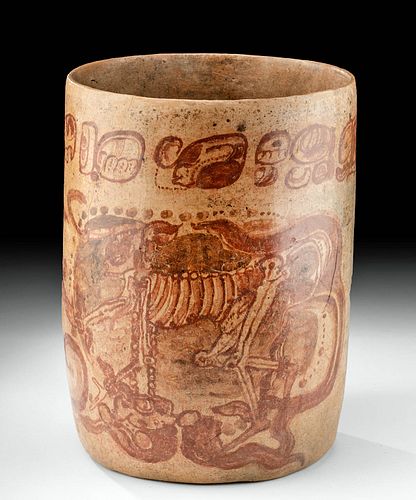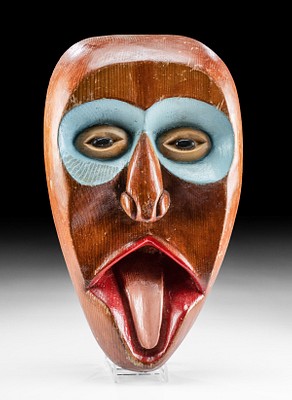Important Maya Pottery Cylinder Vessel - Kerr Database
Lot 163
About Seller
Artemis Fine Arts
686 S Taylor Ave, Ste 106
Louisville, CO 80027
United States
Selling antiquities, ancient and ethnographic art online since 1993, Artemis Gallery specializes in Classical Antiquities (Egyptian, Greek, Roman, Near Eastern), Asian, Pre-Columbian, African / Tribal / Oceanographic art. Our extensive inventory includes pottery, stone, metal, wood, glass and textil...Read more
Categories
Estimate:
$32,000 - $48,000
Absentee vs Live bid
Two ways to bid:
- Leave a max absentee bid and the platform will bid on your behalf up to your maximum bid during the live auction.
- Bid live during the auction and your bids will be submitted real-time to the auctioneer.
Bid Increments
| Price | Bid Increment |
|---|---|
| $0 | $25 |
| $300 | $50 |
| $1,000 | $100 |
| $2,000 | $250 |
| $5,000 | $500 |
| $10,000 | $1,000 |
| $20,000 | $2,500 |
| $50,000 | $5,000 |
| $100,000 | $10,000 |
| $200,000 | $20,000 |
About Auction
By Artemis Fine Arts
Sep 9, 2021
Set Reminder
2021-09-09 10:00:00
2021-09-09 10:00:00
America/New_York
Bidsquare
Bidsquare : Art & Artifacts of North America
https://www.bidsquare.com/auctions/artemis-gallery/art-artifacts-of-north-america-7436
Join us for a special auction not to be missed! Collectible Native American art from antiquity to mid-20th century, Spanish Colonial, Latin American, fine & folk art, American frontier items, and much more! Artemis Fine Arts info@artemisgallery.com
Join us for a special auction not to be missed! Collectible Native American art from antiquity to mid-20th century, Spanish Colonial, Latin American, fine & folk art, American frontier items, and much more! Artemis Fine Arts info@artemisgallery.com
- Lot Description
Pre-Columbian, Northern Peten, Guatemala, Maya, Late Classic Period, ca. 550 to 900 CE. Amazing! Presenting macabre and incredibly striking motifs, this is a ceramic cylinder vessel with rich iconography. It was probably given as a gift during a feast and used for drinking cocoa. It is tall, with a wide mouth and an unpronounced rim whose edge is gently curved. It stands on a flat base with gently upturned edges, and the sides taper very slightly to the mouth. One complete side of the exterior body is dominated by a painted profile of a composite skeletal image of God A and Chak (he wears the pendant of Chak) in animal form. He stands on all fours and appears to be inside a darkened cave, possibly the underworld. Glyph bands adorn the top rim and run diagonally up one side. Size: 6.625" W x 9" H (16.8 cm x 22.9 cm)
God A is one of the Maya codical death gods, known to us only from early colonial-era documents and from the work of 19th century scholar Paul Schellas, who named the gods for letters from the Roman alphabet because at the time Maya hieroglyphs could not be read. A figure similar to God A is referred to with many different names by modern Maya people - often Kimi or Ah Puch - and is the Lord of the Underworld (known variously as Xibalba or Mitnal depending on the dialect). God A is often painted as he is here, as partially dead, with grey, decaying flesh and skeletal bone structure. He is meant to be both terrifying and grotesquely funny, and this portrayal, with its askew teeth and bulbous nose, embodies both. Modern Maya folklore still considers God A a threat - creeping around the houses of the sick, waiting to take them to Xibalba.
Showing a chiaroscuro technique seldom seen with such naturalistic result. Note the background behind the WHAY figure is delicately shaded to give the effect of depth, possibly indicating a cave opening, portal to XIB'AL'BA. This area has not been altered by modern restoration! The deity's three-dimensional rib cage, and skeletal arms and legs become even more gruesome with this unique and innovative shading technique used by the scribe.
Published in The Maya Vase Database created by Justin Kerr, Kerr number 9132
Provenance: ex-private Florida, USA collection; ex-Chuck Warren collection, Coconut Grove, Florida, USA, acquired in the 1970s; ex-Erasmo Toledo collection, Coral Gables, Florida, USA, acquired in the 1960s
All items legal to buy/sell under U.S. Statute covering cultural patrimony Code 2600, CHAPTER 14, and are guaranteed to be as described or your money back.
A Certificate of Authenticity will accompany all winning bids.
PLEASE NOTE: Due to recent increases of shipments being seized by Australian & German customs (even for items with pre-UNESCO provenance), we will no longer ship most antiquities and ancient Chinese art to Australia & Germany. For categories of items that are acceptable to ship to Australia or Germany, please contact us directly or work with your local customs brokerage firm.
Display stands not described as included/custom in the item description are for photography purposes only and will not be included with the item upon shipping.
#161062Professionally repaired from multiple pieces with restoration over the break lines. Normal surface wear commensurate with age. Imagery is still very strong.Condition
- Shipping Info
-
All shipping is handled in-house for your convenience. Your invoice from Artemis Gallery will include shipping calculation instructions. If in doubt, please inquire BEFORE bidding for estimated shipping costs for individual items.
-
- Buyer's Premium



 EUR
EUR CAD
CAD AUD
AUD GBP
GBP MXN
MXN HKD
HKD CNY
CNY MYR
MYR SEK
SEK SGD
SGD CHF
CHF THB
THB
















